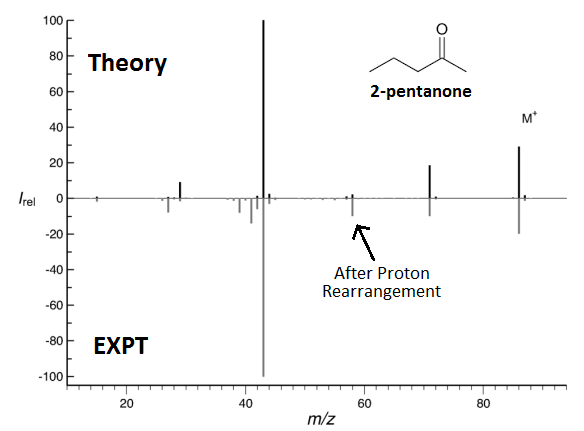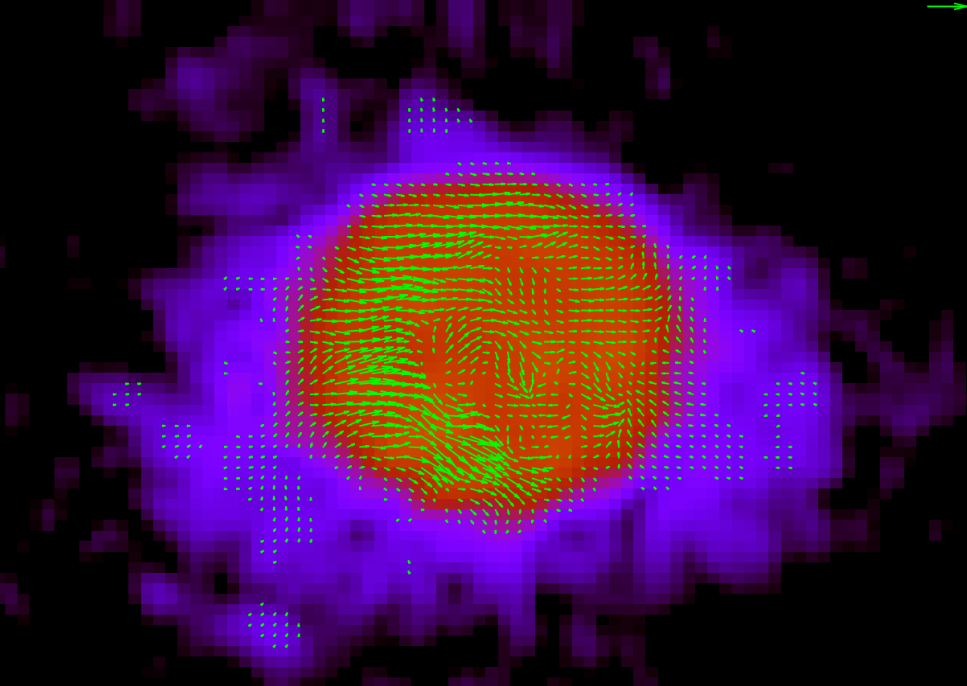Dr. Cody Covington
Physical and Computational Chemistry (of many different flavors)

About
I am an adjunct faculty member here at APSU. I actually went to school here as an undergraduate, after which received a Ph.D. from the Vanderbilt University Department of Chemistry with Dr. Prasad Polavarapu. I did a short postdoc with the Vanderbilt Department of Physics and Astronomy with Dr. Kalman Varga.
My hobbies include tennis, fishing, and 3-D printing. I enjoy long walks on the beach and all that stuff…
Research: Prediction of electron impact fragmentation mass spectrometry
As our goals in science advance, we strive to study smaller and smaller size scales, and in several fields of chemistry this may manifest in the identification and characterization using very small quantities of substance. For decades Mass Spectrometry (MS) has been at the forefront, providing unrivaled sensitivity, detection limits, and speed. Yet a compound cannot be identified without a reference, and each species may be effected differently by the ionization method. If a compound’s structure could be determined from their fragmentation mass spectrum alone, it could completely change analytical chemistry and analytical biochemistry as we know it. To date the most accurate method for predicting mass spectra is known as the Quantum Chemistry Electron Ionization Mass Spectrometry (QCEIMS) method, and although this represents a step in the right direction, suffers from several complications.3 If the issues with the QCEIMS method could be resolved, the long desired goal of identifying novel compounds from the mass spectrum alone could be possible.
 An example QCEIMS spectrum for 2-pentanone
An example QCEIMS spectrum for 2-pentanone
Research: Ionization of atoms and molecules in strong lasers
The conversion of electromagnetic waves into collective excitations of electrons has created a new research field called plasmonics, which includes a wide range of important applications in nanophotonics, biology, sensing, single molecule detection, nanophotonic lasers, photovoltaic devices, spectroscopy and solar energy harvesting. By the constant miniaturization of electronic and optical devices towards the nanoscale, plasmonics enters the quantum regime where simulations using classical approaches fail. New theoretical and computational approaches are needed to tackle the challenges of quantum plasmonics – the extreme limit of light-matter interactions.
The need to address the quantum effects in plasmonic responses has been well-recognized, and several approaches have been developed to incorporate quantum mechanical effects into classical electrodynamics modeling. Most of these models treat large, hundreds of nanometer size systems with quantum corrections to include nonlocal and surface effects . In these approaches atomistic details are neglected and the quantum mechanical equations are not explicitly considered; the main simulation effects is directed toward macroscopic continuum description.
I have developed quantum mechanical simulation software tools to model the quantum effects in materials by coupling the electromagnetic waves and electron dynamics at the atomistic level. Currently extensive calculations are necessary to describe the interaction of electromagnetic fields and matter in the quantum regime where electron correlations and tunneling, confinement and interference play a decisive role. The quantum limit of plasmonics will be investigated and possible ways to take advantage of quantum effects will be explored. The ultimate goal is to understand the influence of the complex interplay of photons, single electron transitions, plasmons and the motion of atoms on optical responses, with particular emphasis on strong quantum effects and nonlinearities.

An example calculation showing a snapshot of a lithium (jellium) nanoparticle irradiated by a laser. The electron density in pseudo color (red-black) and the induced electron current vectors are shown by the green arrows.
Publications
- Covington, C.L.; Absolute Configuration of an Axially Chiral Sulfonate Determined From Its Optical Rotatory Dispersion, Electronic Circular Dichroism and Vibrational Circular Dichroism Spectra, Chirality, 2017 29 (11), 670-676
- Polavarapu, P. L.; Covington, C. L.; Raghavan, V. To Avoid Chasing Incorrect Chemical Structures of Chiral Compounds: Raman Optical Activity and Vibrational Circular Dichroism Spectroscopies, ChemPhysChem, 2017 18, 2459–2465
- Covington, C.; Hartig, K.; Russakoff, A.; Kulpins, R.; Varga, K. Time-dependent density-functional-theory investigation of the collisions of protons and alpha particles with uracil and adenine, Rev. A, 2017 95, 52701
- Erattupuzha, S.; Covington, C.; Russakoff, A.; Lotstedt, E.; Larimian, S.; Hanus, V.; Bubin, S.; Koch, M.; Graefe, S.; Baltuska, A.; Xie, X.; Yamanouchi, K.; Varga, K.; Kitzler, M. Enhanced ionization of polyatomic molecules in intense laser pulses is due to energy upshift and field coupling of multiple orbitals, Phys. B, 2017 50, 125601
- Covington, C. L.; Polavarapu, P. L. CDSpecTech: A single software suite for multiple Chiroptical spectroscopic analyses, chirality 2017, 29, 178
- Blons C.; Morin M. S. T.; Schmid T. E.; Vives T., Colombel-Rouen S.; Baslé O., Reynaldo T.; Covington C. L.; Halbert S.; Cuskelly S. N.; Bernhardt P. V.; Williams C. M.; Crassous J.; Polavarapu P. L.; Crévisy C.; Gérard H., Mauduit M. Asymmetric Sequential Cu-Catalyzed 1,6/1,4 Conjugate Additions of Hard Nucleophiles to Cyclic Dienones. Determination of Absolute Configurations and Origins of Enantioselectivity, Eur. J, 2017 23, 7515-7525
- Covington, C.; Kidd, D.; Gilmer, J.; Varga, K. Simulation of electron dynamics subject to intense laser fields using a time-dependent Volkov basis, Rev. A 2017 95, 013414
- Covington, C. L., Junior, F. M., Silva, J. H., Kuster, R. M., de Amorim, M. B. and Polavarapu, P. L., 2016. Atropoisomerism in Biflavones: The Absolute Configuration of (−)-Agathisflavone via Chiroptical Spectroscopy. Nat. Prod. 2016 79, 2530-2537
- Polavarapu P. L.; Covington C. L.; Chruszcz‐Lipska K.; Zajac G.; Baranska M. Vibrational Raman optical activity of bicyclic terpenes: comparison between experimental and calculated vibrational Raman, Raman optical activity, and dimensionless circular intensity difference spectra and their similarity analysis. Raman Spectrosc. 2016 48, 305-313
- Covington, C. L.; Polavarapu, P. L. Solvation dependence observed in the electronic dissymmetry factor spectra: how much information are we missing by analyzing the circular dichroism spectra alone?, Chem. Chem. Phys. 2016, 18, 13912-13917
- Covington, C. L.; Polavarapu, P. L. Concentration Dependent Specific Rotations of Chiral Surfactants: Experimental and Computational Studies, Phys. Chem. A, 2016, 120(28), 5715
- Covington, C. L. Chiroptical Spectroscopic Studies on Surfactants, Other Aggregating Systems, and Natural Products. Ph.D. Dissertation, Vanderbilt University, Nashville, TN, 2016
- Covington, C. L.; Polavarapu, P. L. Specific Optical Rotations and the Horeau effect, Chirality 2015, 3, 181
- Junior, M. S. F.; Covington, C. L.; de Albuquerque, A. C. F.; Lobo, J.F.R.; Borges, R.M.; de Amorim, M. B.; Polavarapu, P. L. Absolute Configuration of (-)-Centratherin, a Sesquiterpenoid Lactone, Defined by Means of Chiroptical Spectroscopy, Nat. Prod 2015, 78, 2617
- Covington, C. L.; Nicu, V. P.; Polavarapu, P. L. Determination of the Absolute Configurations Using Exciton Chirality Method for Vibrational Circular Dichroism: Right Answers for the Wrong Reasons? Phys. Chem. A, 2015, 119, 10589–10601
- Polavarapu, P. L.; Covington, C. L. Wavelength resolved specific optical rotations and homochiral equilibria, Chem. Chem. Phys., 2015,17, 21630-21633
- Polavarapu, P. L.; Covington, C. L. Comparison of Experimental and Calculated Chiroptical Spectra for Chiral Molecular Structure Determination, Chirality 2014, 26, 179-192
- Junior, M. S. F.; Covington, C. L.; de Amorim, M. B.; Velozo, L. S. L.; Kaplan, M. A.; Polavarapu, P. L. The Absolute Configuration of a Rare Sesquiterpene: (+)-3-Ishwarone, Nat. Prod 2014, 77, 1881-1886
- Derewacz, D. K.; McNees, R. C.; Scalmani, G.; Covington, C. L.; Shanmugam, G.; Marnett, L. J.; Polavarapu, P. L.; Bachmann, B. O. Structure and Stereochemical Determination of Hypogeamicins from a Cave-Derived Actinomycete, Nat. Prod 2014, 77, 1759-1763
- Covington, C. L.; Polavarapu, P. L. Similarity in Dissymmetry Factor Spectra: a Quantitative Measure of Comparison between Experimental and Predicted Vibrational Circular Dichroism, Phys. Chem. A 2013, 117, 3377-3386